5 Association Analysis: Basic Concepts and Algorithms
This chapter introduces association rules mining using the APRIORI algorithm. In addition, analyzing sets of association rules using visualization techniques is demonstrated.
The corresponding chapter of the data mining textbook is available online: Chapter 5: Association Analysis: Basic Concepts and Algorithms.
Packages Used in this Chapter
pkgs <- c("arules", "arulesViz", "mlbench", "palmerpenguins", "tidyverse")
pkgs_install <- pkgs[!(pkgs %in% installed.packages()[,"Package"])]
if(length(pkgs_install)) install.packages(pkgs_install)The packages used for this chapter are: arules (Hahsler et al. 2024), arulesViz (Hahsler 2024), mlbench (Leisch and Dimitriadou 2024), palmerpenguins (Horst, Hill, and Gorman 2022), tidyverse (Wickham 2023c)
5.1 Preliminaries
Association rule mining plays a vital role in discovering hidden patterns and relationships within large transactional datasets. Applications range from exploratory data analysis in marketing to building rule-based classifiers. Agrawal, Imielinski, and Swami (1993) introduced the problem of mining association rules from transaction data as follows (the definition is taken from Hahsler, Grün, and Hornik (2005)):
Let \(I = \{i_1,i_2,...,i_n\}\) be a set of \(n\) binary attributes called items. Let \(D = \{t_1,t_2,...,t_m\}\) be a set of transactions called the database. Each transaction in \(D\) has a unique transaction ID and contains a subset of the items in \(I\). A rule is defined as an implication of the form \(X \Rightarrow Y\) where \(X,Y \subseteq I\) and \(X \cap Y = \emptyset\) are called itemsets. On itemsets and rules several quality measures can be defined. The most important measures are support and confidence. The support \(supp(X)\) of an itemset \(X\) is defined as the proportion of transactions in the data set which contain the itemset. Itemsets with a support which surpasses a user-defined threshold \(\sigma\) are called frequent itemsets. The confidence of a rule is defined as \(conf(X \Rightarrow Y) = supp(X \cup Y)/supp(X)\). Association rules are rules with \(supp(X \cup Y) \ge \sigma\) and \(conf(X) \ge \delta\) where \(\sigma\) and \(\delta\) are user-defined thresholds. The found set of association rules is then used reason about the data.
You can read the free sample chapter from the textbook (Tan, Steinbach, and Kumar 2005): Chapter 5. Association Analysis: Basic Concepts and Algorithms
5.1.1 The arules Package
Association rule mining in R is implemented in the package arules.
For information about the arules package try: help(package="arules")
and vignette("arules") (also available at
CRAN)
arules uses the S4 object system to implement classes and methods.
Standard R objects use the S3 object
system which do not use formal class
definitions and are usually implemented as a list with a class
attribute. arules and many other R packages use the S4 object
system which is based on formal class
definitions with member variables and methods (similar to
object-oriented programming languages like Java and C++). Some important
differences of using S4 objects compared to the usual S3 objects are:
- coercion (casting):
as(from, "class_name") - help for classes:
class? class_name
5.1.2 Transactions
5.1.2.1 Create Transactions
We will use the Zoo dataset from mlbench.
data(Zoo, package = "mlbench")
head(Zoo)
## hair feathers eggs milk airborne aquatic predator toothed
## aardvark TRUE FALSE FALSE TRUE FALSE FALSE TRUE TRUE
## antelope TRUE FALSE FALSE TRUE FALSE FALSE FALSE TRUE
## bass FALSE FALSE TRUE FALSE FALSE TRUE TRUE TRUE
## bear TRUE FALSE FALSE TRUE FALSE FALSE TRUE TRUE
## boar TRUE FALSE FALSE TRUE FALSE FALSE TRUE TRUE
## buffalo TRUE FALSE FALSE TRUE FALSE FALSE FALSE TRUE
## backbone breathes venomous fins legs tail domestic catsize
## aardvark TRUE TRUE FALSE FALSE 4 FALSE FALSE TRUE
## antelope TRUE TRUE FALSE FALSE 4 TRUE FALSE TRUE
## bass TRUE FALSE FALSE TRUE 0 TRUE FALSE FALSE
## bear TRUE TRUE FALSE FALSE 4 FALSE FALSE TRUE
## boar TRUE TRUE FALSE FALSE 4 TRUE FALSE TRUE
## buffalo TRUE TRUE FALSE FALSE 4 TRUE FALSE TRUE
## type
## aardvark mammal
## antelope mammal
## bass fish
## bear mammal
## boar mammal
## buffalo mammalThe data in the data.frame need to be converted into a set of
transactions where each row represents a transaction and each column is
translated into items. This is done using the constructor
transactions(). For the Zoo data set this means that we consider
animals as transactions and the different traits (features) will become
items that each animal has. For example the animal antelope has the
item hair in its transaction.
trans <- transactions(Zoo)
## Warning: Column(s) 13 not logical or factor. Applying default
## discretization (see '? discretizeDF').The conversion gives a warning because only discrete features (factor
and logical) can be directly translated into items. Continuous
features need to be discretized first.
What is column 13?
summary(Zoo[13])
## legs
## Min. :0.00
## 1st Qu.:2.00
## Median :4.00
## Mean :2.84
## 3rd Qu.:4.00
## Max. :8.00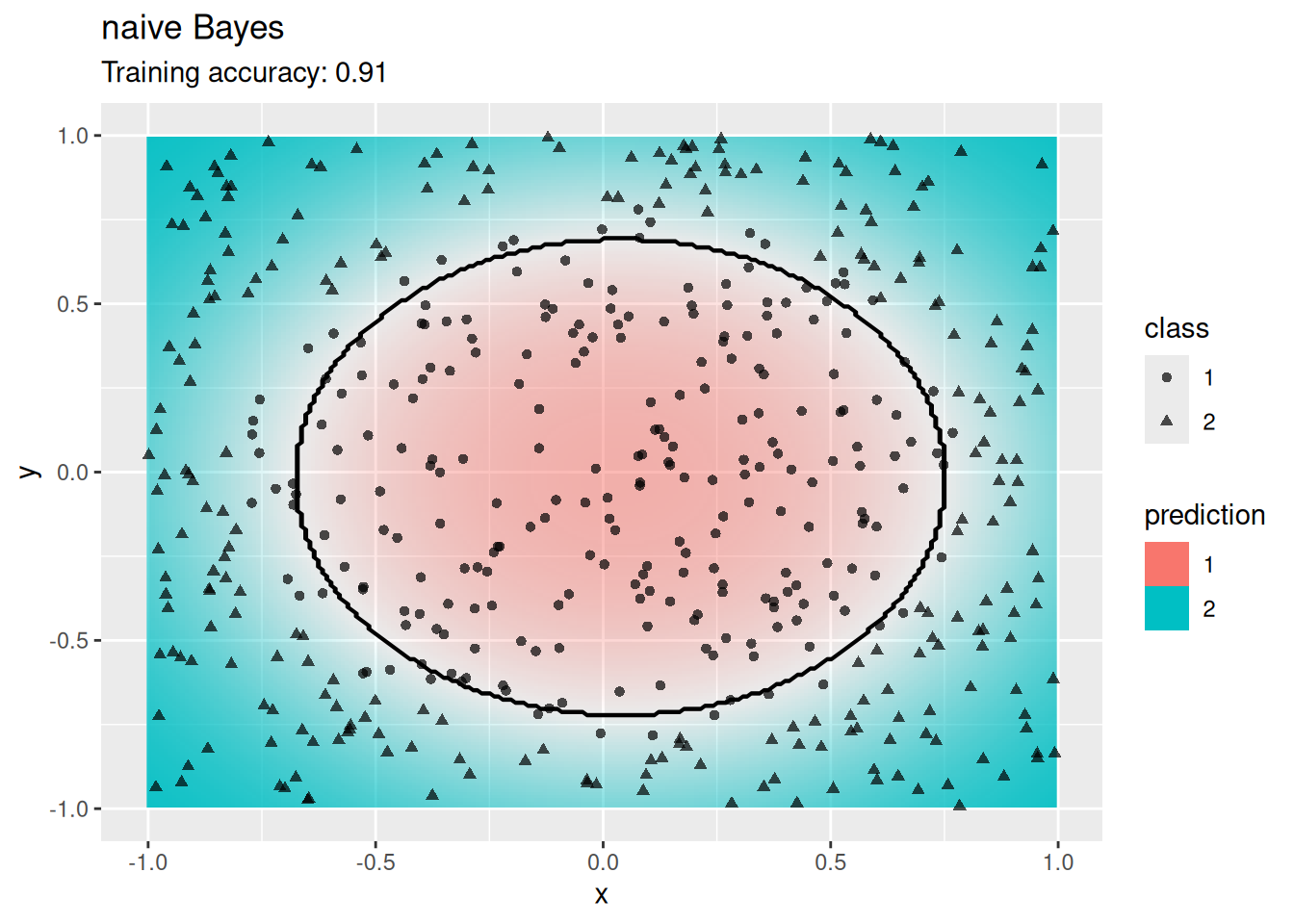
Zoo$legs |> table()
##
## 0 2 4 5 6 8
## 23 27 38 1 10 2Possible solution: Make legs into has/does not have legs
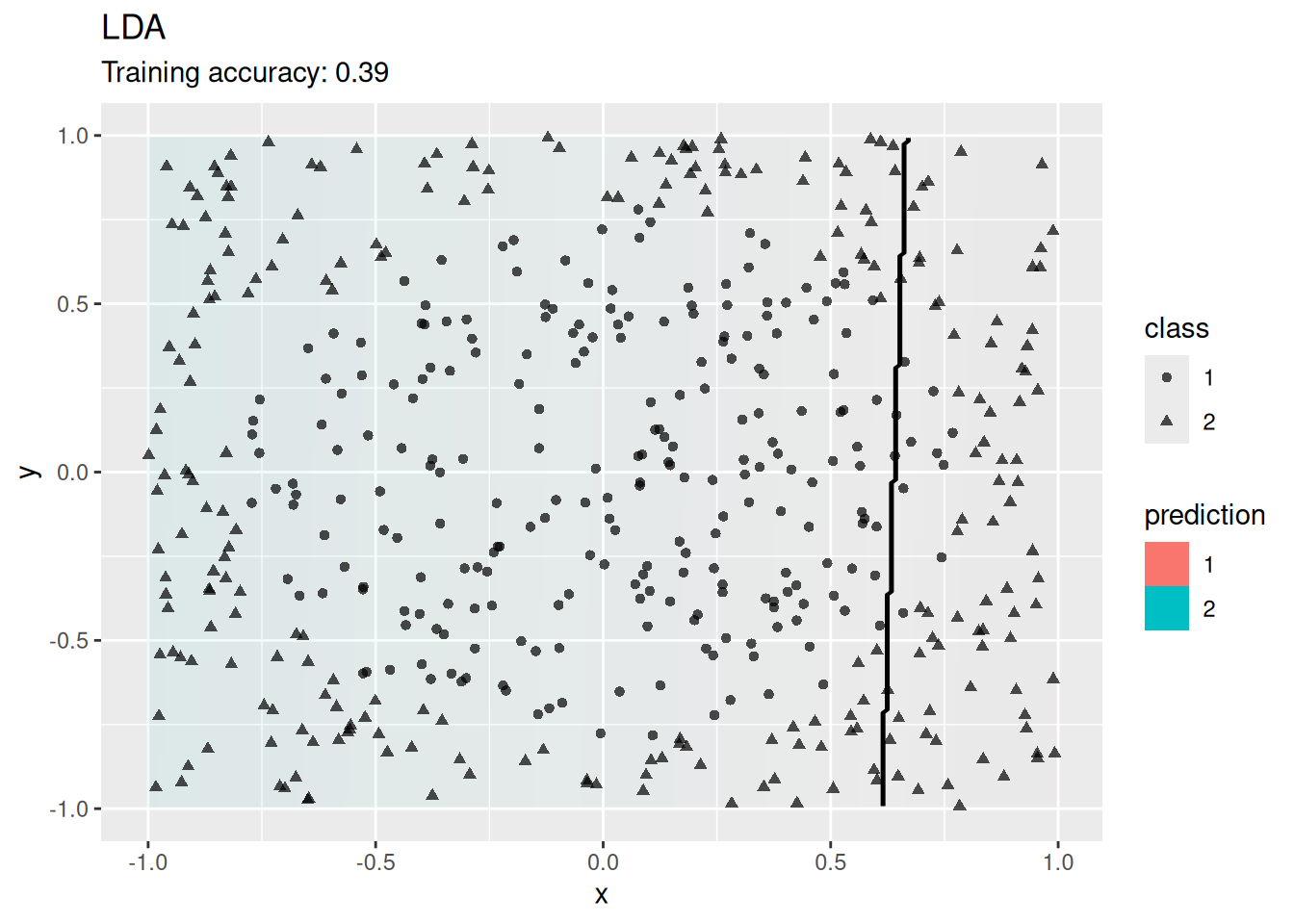
Zoo_has_legs$legs |> table()
##
## FALSE TRUE
## 23 78Alternatives:
- use each unique value as an item:
Zoo_unique_leg_values <- Zoo |> mutate(legs = factor(legs))
Zoo_unique_leg_values$legs |> head()
## [1] 4 4 0 4 4 4
## Levels: 0 2 4 5 6 8- discretize (see
? discretizeand discretization in the code for Chapter 2):
Zoo_discretized_legs <- Zoo |> mutate(
legs = discretize(legs, breaks = 2, method="interval")
)
table(Zoo_discretized_legs$legs)
##
## [0,4) [4,8]
## 50 51Convert data into a set of transactions
trans <- transactions(Zoo_has_legs)
trans
## transactions in sparse format with
## 101 transactions (rows) and
## 23 items (columns)5.1.2.2 Inspect Transactions
summary(trans)
## transactions as itemMatrix in sparse format with
## 101 rows (elements/itemsets/transactions) and
## 23 columns (items) and a density of 0.3612
##
## most frequent items:
## backbone breathes legs tail toothed (Other)
## 83 80 78 75 61 462
##
## element (itemset/transaction) length distribution:
## sizes
## 3 4 5 6 7 8 9 10 11 12
## 3 2 6 5 8 21 27 25 3 1
##
## Min. 1st Qu. Median Mean 3rd Qu. Max.
## 3.00 8.00 9.00 8.31 10.00 12.00
##
## includes extended item information - examples:
## labels variables levels
## 1 hair hair TRUE
## 2 feathers feathers TRUE
## 3 eggs eggs TRUE
##
## includes extended transaction information - examples:
## transactionID
## 1 aardvark
## 2 antelope
## 3 bassLook at created items. They are still called column names since the transactions are actually stored as a large sparse logical matrix (see below).
colnames(trans)
## [1] "hair" "feathers" "eggs"
## [4] "milk" "airborne" "aquatic"
## [7] "predator" "toothed" "backbone"
## [10] "breathes" "venomous" "fins"
## [13] "legs" "tail" "domestic"
## [16] "catsize" "type=mammal" "type=bird"
## [19] "type=reptile" "type=fish" "type=amphibian"
## [22] "type=insect" "type=mollusc.et.al"Compare with the original features (column names) from Zoo
colnames(Zoo)
## [1] "hair" "feathers" "eggs" "milk" "airborne" "aquatic"
## [7] "predator" "toothed" "backbone" "breathes" "venomous" "fins"
## [13] "legs" "tail" "domestic" "catsize" "type"Look at a (first) few transactions as a matrix. 1 indicates the presence of an item.
as(trans, "matrix")[1:3,]
## hair feathers eggs milk airborne aquatic predator toothed
## aardvark TRUE FALSE FALSE TRUE FALSE FALSE TRUE TRUE
## antelope TRUE FALSE FALSE TRUE FALSE FALSE FALSE TRUE
## bass FALSE FALSE TRUE FALSE FALSE TRUE TRUE TRUE
## backbone breathes venomous fins legs tail domestic
## aardvark TRUE TRUE FALSE FALSE TRUE FALSE FALSE
## antelope TRUE TRUE FALSE FALSE TRUE TRUE FALSE
## bass TRUE FALSE FALSE TRUE FALSE TRUE FALSE
## catsize type=mammal type=bird type=reptile type=fish
## aardvark TRUE TRUE FALSE FALSE FALSE
## antelope TRUE TRUE FALSE FALSE FALSE
## bass FALSE FALSE FALSE FALSE TRUE
## type=amphibian type=insect type=mollusc.et.al
## aardvark FALSE FALSE FALSE
## antelope FALSE FALSE FALSE
## bass FALSE FALSE FALSELook at the transactions as sets of items
inspect(trans[1:3])
## items transactionID
## [1] {hair,
## milk,
## predator,
## toothed,
## backbone,
## breathes,
## legs,
## catsize,
## type=mammal} aardvark
## [2] {hair,
## milk,
## toothed,
## backbone,
## breathes,
## legs,
## tail,
## catsize,
## type=mammal} antelope
## [3] {eggs,
## aquatic,
## predator,
## toothed,
## backbone,
## fins,
## tail,
## type=fish} bassPlot the binary matrix. Dark dots represent 1s.
image(trans)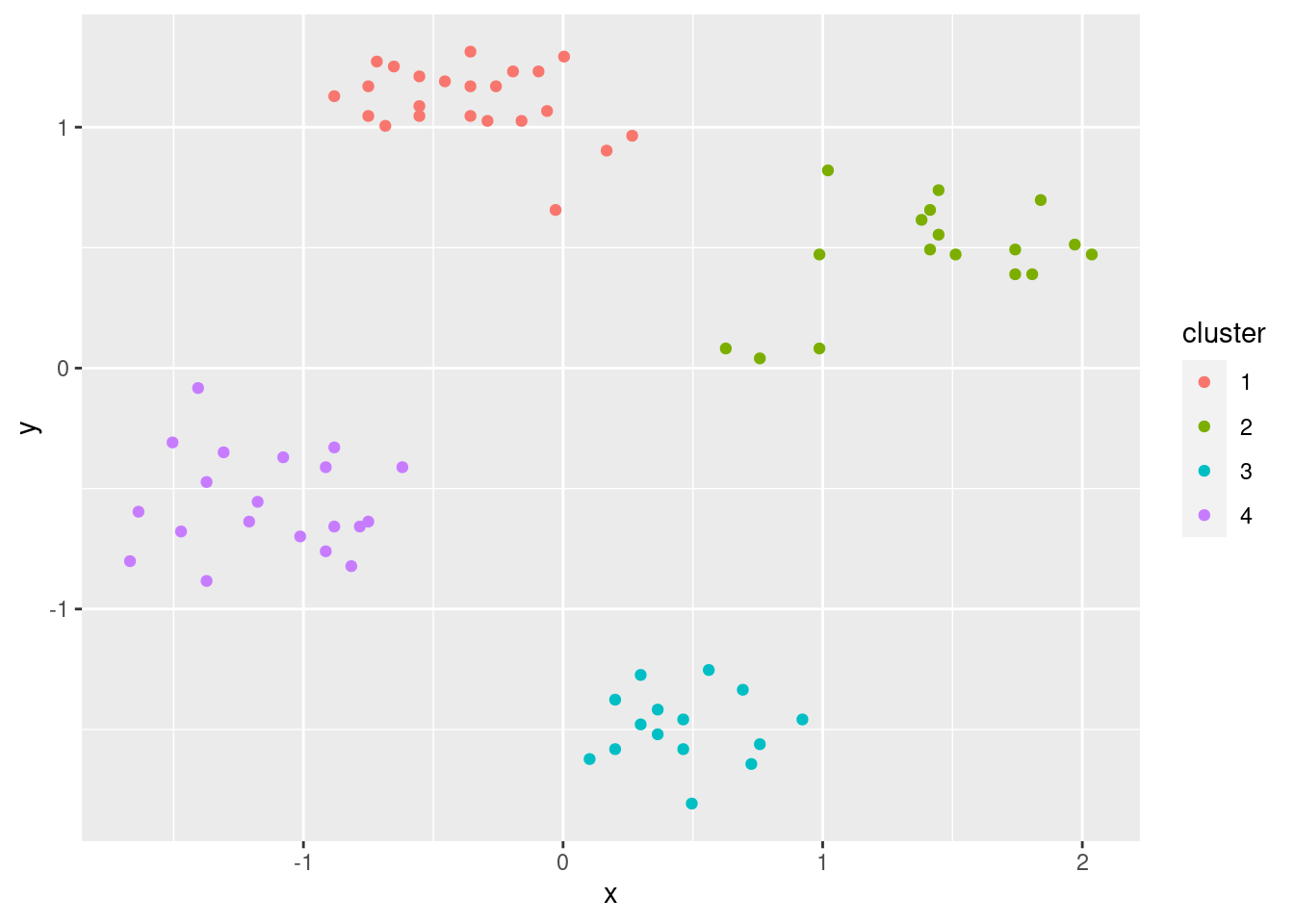
Look at the relative frequency (=support) of items in the data set. Here we look at the 10 most frequent items.
itemFrequencyPlot(trans,topN = 20)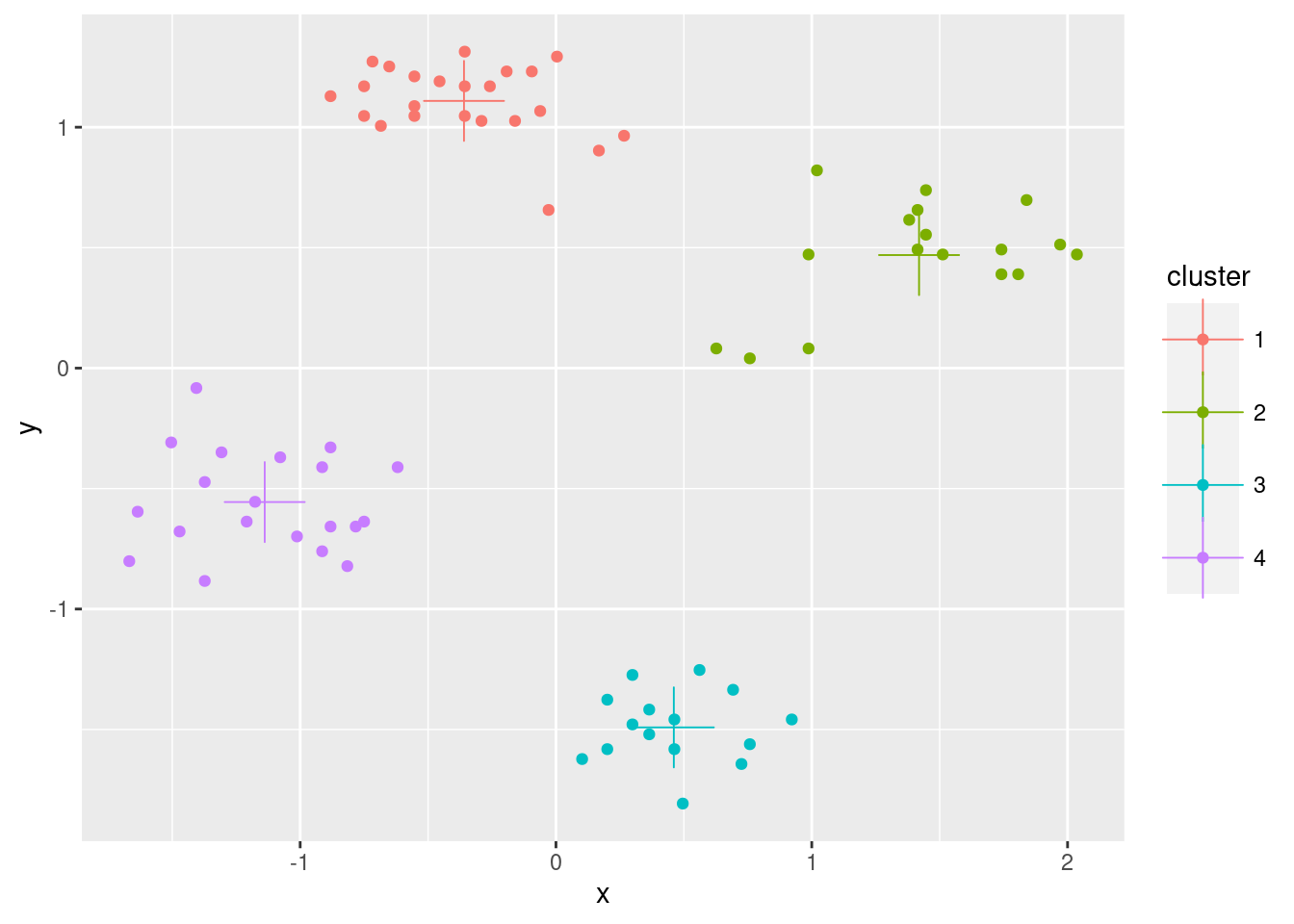
ggplot(
tibble(
Support = sort(itemFrequency(trans, type = "absolute"), decreasing = TRUE),
Item = seq_len(ncol(trans))
), aes(x = Item, y = Support)) + geom_line()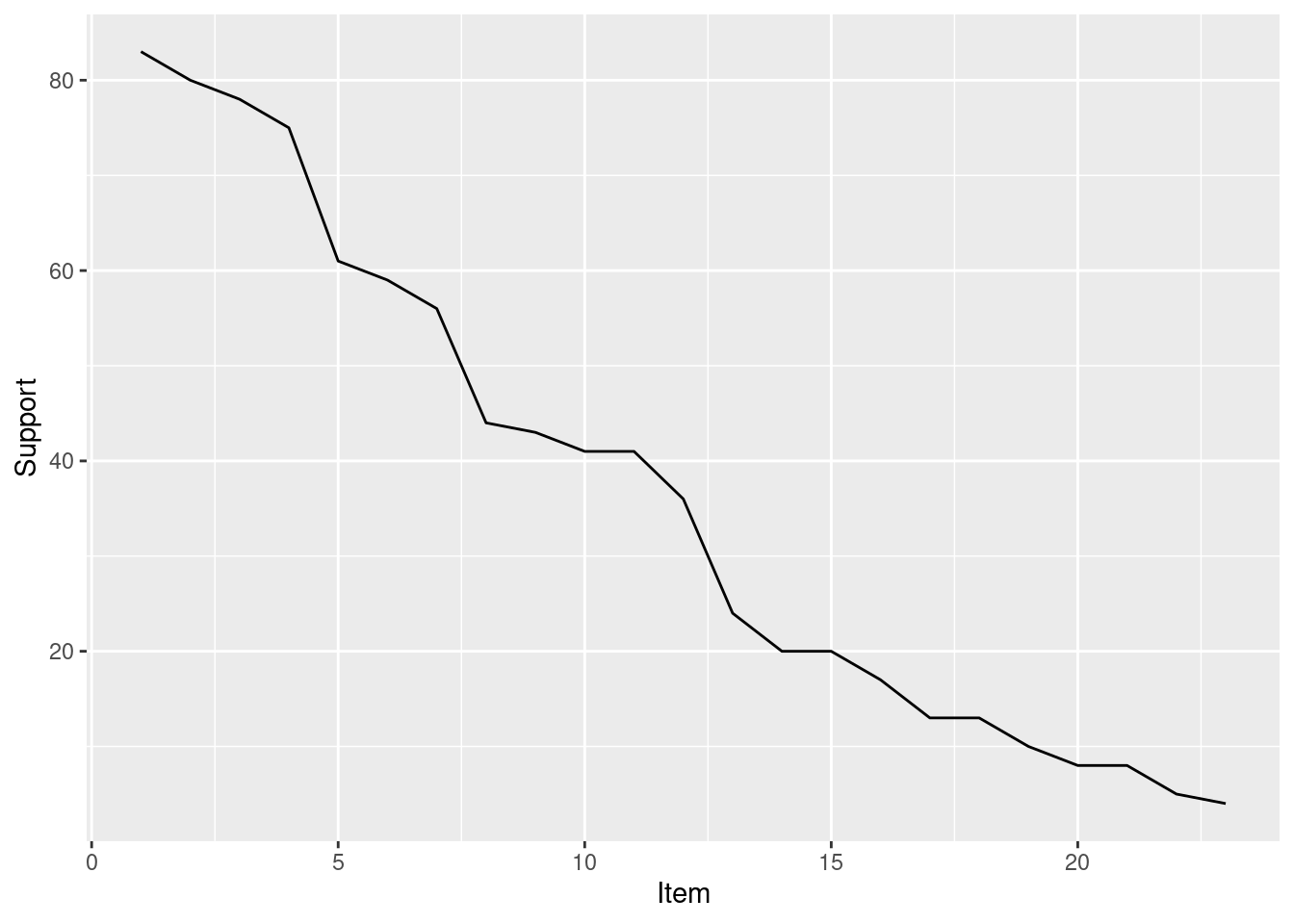
Alternative encoding: Also create items for FALSE (use factor)
sapply(Zoo_has_legs, class)
## hair feathers eggs milk airborne aquatic predator
## "logical" "logical" "logical" "logical" "logical" "logical" "logical"
## toothed backbone breathes venomous fins legs tail
## "logical" "logical" "logical" "logical" "logical" "logical" "logical"
## domestic catsize type
## "logical" "logical" "factor"
Zoo_factors <- Zoo_has_legs |> mutate(across(where(is.logical), factor))
sapply(Zoo_factors, class)
## hair feathers eggs milk airborne aquatic predator
## "factor" "factor" "factor" "factor" "factor" "factor" "factor"
## toothed backbone breathes venomous fins legs tail
## "factor" "factor" "factor" "factor" "factor" "factor" "factor"
## domestic catsize type
## "factor" "factor" "factor"
summary(Zoo_factors)
## hair feathers eggs milk airborne aquatic
## FALSE:58 FALSE:81 FALSE:42 FALSE:60 FALSE:77 FALSE:65
## TRUE :43 TRUE :20 TRUE :59 TRUE :41 TRUE :24 TRUE :36
##
##
##
##
##
## predator toothed backbone breathes venomous fins
## FALSE:45 FALSE:40 FALSE:18 FALSE:21 FALSE:93 FALSE:84
## TRUE :56 TRUE :61 TRUE :83 TRUE :80 TRUE : 8 TRUE :17
##
##
##
##
##
## legs tail domestic catsize type
## FALSE:23 FALSE:26 FALSE:88 FALSE:57 mammal :41
## TRUE :78 TRUE :75 TRUE :13 TRUE :44 bird :20
## reptile : 5
## fish :13
## amphibian : 4
## insect : 8
## mollusc.et.al:10
trans_factors <- transactions(Zoo_factors)
trans_factors
## transactions in sparse format with
## 101 transactions (rows) and
## 39 items (columns)
itemFrequencyPlot(trans_factors, topN = 20)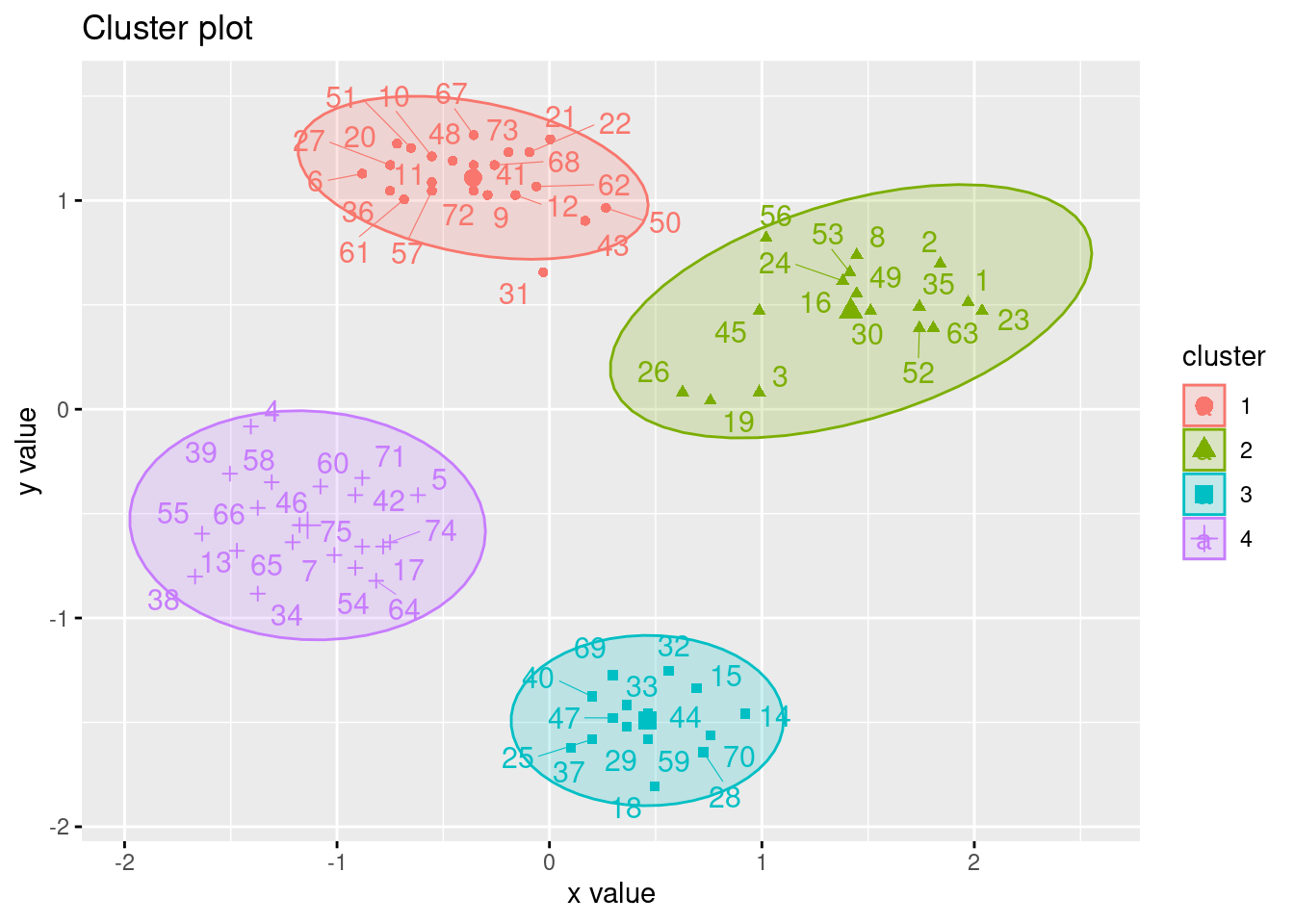
## Select transactions that contain a certain item
trans_insects <- trans_factors[trans %in% "type=insect"]
trans_insects
## transactions in sparse format with
## 8 transactions (rows) and
## 39 items (columns)
inspect(trans_insects)
## items transactionID
## [1] {hair=FALSE,
## feathers=FALSE,
## eggs=TRUE,
## milk=FALSE,
## airborne=FALSE,
## aquatic=FALSE,
## predator=FALSE,
## toothed=FALSE,
## backbone=FALSE,
## breathes=TRUE,
## venomous=FALSE,
## fins=FALSE,
## legs=TRUE,
## tail=FALSE,
## domestic=FALSE,
## catsize=FALSE,
## type=insect} flea
## [2] {hair=FALSE,
## feathers=FALSE,
## eggs=TRUE,
## milk=FALSE,
## airborne=TRUE,
## aquatic=FALSE,
## predator=FALSE,
## toothed=FALSE,
## backbone=FALSE,
## breathes=TRUE,
## venomous=FALSE,
## fins=FALSE,
## legs=TRUE,
## tail=FALSE,
## domestic=FALSE,
## catsize=FALSE,
## type=insect} gnat
## [3] {hair=TRUE,
## feathers=FALSE,
## eggs=TRUE,
## milk=FALSE,
## airborne=TRUE,
## aquatic=FALSE,
## predator=FALSE,
## toothed=FALSE,
## backbone=FALSE,
## breathes=TRUE,
## venomous=TRUE,
## fins=FALSE,
## legs=TRUE,
## tail=FALSE,
## domestic=TRUE,
## catsize=FALSE,
## type=insect} honeybee
## [4] {hair=TRUE,
## feathers=FALSE,
## eggs=TRUE,
## milk=FALSE,
## airborne=TRUE,
## aquatic=FALSE,
## predator=FALSE,
## toothed=FALSE,
## backbone=FALSE,
## breathes=TRUE,
## venomous=FALSE,
## fins=FALSE,
## legs=TRUE,
## tail=FALSE,
## domestic=FALSE,
## catsize=FALSE,
## type=insect} housefly
## [5] {hair=FALSE,
## feathers=FALSE,
## eggs=TRUE,
## milk=FALSE,
## airborne=TRUE,
## aquatic=FALSE,
## predator=TRUE,
## toothed=FALSE,
## backbone=FALSE,
## breathes=TRUE,
## venomous=FALSE,
## fins=FALSE,
## legs=TRUE,
## tail=FALSE,
## domestic=FALSE,
## catsize=FALSE,
## type=insect} ladybird
## [6] {hair=TRUE,
## feathers=FALSE,
## eggs=TRUE,
## milk=FALSE,
## airborne=TRUE,
## aquatic=FALSE,
## predator=FALSE,
## toothed=FALSE,
## backbone=FALSE,
## breathes=TRUE,
## venomous=FALSE,
## fins=FALSE,
## legs=TRUE,
## tail=FALSE,
## domestic=FALSE,
## catsize=FALSE,
## type=insect} moth
## [7] {hair=FALSE,
## feathers=FALSE,
## eggs=TRUE,
## milk=FALSE,
## airborne=FALSE,
## aquatic=FALSE,
## predator=FALSE,
## toothed=FALSE,
## backbone=FALSE,
## breathes=TRUE,
## venomous=FALSE,
## fins=FALSE,
## legs=TRUE,
## tail=FALSE,
## domestic=FALSE,
## catsize=FALSE,
## type=insect} termite
## [8] {hair=TRUE,
## feathers=FALSE,
## eggs=TRUE,
## milk=FALSE,
## airborne=TRUE,
## aquatic=FALSE,
## predator=FALSE,
## toothed=FALSE,
## backbone=FALSE,
## breathes=TRUE,
## venomous=TRUE,
## fins=FALSE,
## legs=TRUE,
## tail=FALSE,
## domestic=FALSE,
## catsize=FALSE,
## type=insect} wasp5.1.2.3 Vertical Layout (Transaction ID Lists)
The default layout for transactions is horizontal layout (i.e. each transaction is a row). The vertical layout represents transaction data as a list of transaction IDs for each item (= transaction ID lists).
vertical <- as(trans, "tidLists")
as(vertical, "matrix")[1:10, 1:5]
## aardvark antelope bass bear boar
## hair TRUE TRUE FALSE TRUE TRUE
## feathers FALSE FALSE FALSE FALSE FALSE
## eggs FALSE FALSE TRUE FALSE FALSE
## milk TRUE TRUE FALSE TRUE TRUE
## airborne FALSE FALSE FALSE FALSE FALSE
## aquatic FALSE FALSE TRUE FALSE FALSE
## predator TRUE FALSE TRUE TRUE TRUE
## toothed TRUE TRUE TRUE TRUE TRUE
## backbone TRUE TRUE TRUE TRUE TRUE
## breathes TRUE TRUE FALSE TRUE TRUE5.2 Frequent Itemset Generation
For this dataset we have already a huge number of possible itemsets
2^ncol(trans)
## [1] 8388608Find frequent itemsets (target=“frequent”) with the default settings.
its <- apriori(trans, parameter=list(target = "frequent"))
## Apriori
##
## Parameter specification:
## confidence minval smax arem aval originalSupport maxtime support
## NA 0.1 1 none FALSE TRUE 5 0.1
## minlen maxlen target ext
## 1 10 frequent itemsets TRUE
##
## Algorithmic control:
## filter tree heap memopt load sort verbose
## 0.1 TRUE TRUE FALSE TRUE 2 TRUE
##
## Absolute minimum support count: 10
##
## set item appearances ...[0 item(s)] done [0.00s].
## set transactions ...[23 item(s), 101 transaction(s)] done [0.00s].
## sorting and recoding items ... [18 item(s)] done [0.00s].
## creating transaction tree ... done [0.00s].
## checking subsets of size 1 2 3 4 5 6 7 8 9 10
## Warning in apriori(trans, parameter = list(target = "frequent")):
## Mining stopped (maxlen reached). Only patterns up to a length of 10
## returned!
## done [0.00s].
## sorting transactions ... done [0.00s].
## writing ... [1465 set(s)] done [0.00s].
## creating S4 object ... done [0.00s].
its
## set of 1465 itemsetsDefault minimum support is .1 (10%). Note: We use here a very small data set. For larger datasets the default minimum support might be to low and you may run out of memory. You probably want to start out with a higher minimum support like .5 (50%) and then work your way down.
5/nrow(trans)
## [1] 0.0495In order to find itemsets that effect 5 animals I need to go down to a support of about 5%.
its <- apriori(trans, parameter=list(target = "frequent", support = 0.05))
## Apriori
##
## Parameter specification:
## confidence minval smax arem aval originalSupport maxtime support
## NA 0.1 1 none FALSE TRUE 5 0.05
## minlen maxlen target ext
## 1 10 frequent itemsets TRUE
##
## Algorithmic control:
## filter tree heap memopt load sort verbose
## 0.1 TRUE TRUE FALSE TRUE 2 TRUE
##
## Absolute minimum support count: 5
##
## set item appearances ...[0 item(s)] done [0.00s].
## set transactions ...[23 item(s), 101 transaction(s)] done [0.00s].
## sorting and recoding items ... [21 item(s)] done [0.00s].
## creating transaction tree ... done [0.00s].
## checking subsets of size 1 2 3 4 5 6 7 8 9 10
## Warning in apriori(trans, parameter = list(target = "frequent",
## support = 0.05)): Mining stopped (maxlen reached). Only patterns up
## to a length of 10 returned!
## done [0.00s].
## sorting transactions ... done [0.00s].
## writing ... [2537 set(s)] done [0.00s].
## creating S4 object ... done [0.00s].
its
## set of 2537 itemsetsSort by support
its <- sort(its, by = "support")
its |> head(n = 10) |> inspect()
## items support count
## [1] {backbone} 0.8218 83
## [2] {breathes} 0.7921 80
## [3] {legs} 0.7723 78
## [4] {tail} 0.7426 75
## [5] {backbone, tail} 0.7327 74
## [6] {breathes, legs} 0.7228 73
## [7] {backbone, breathes} 0.6832 69
## [8] {backbone, legs} 0.6337 64
## [9] {backbone, breathes, legs} 0.6337 64
## [10] {toothed} 0.6040 61Look at frequent itemsets with many items (set breaks manually since Automatically chosen breaks look bad)
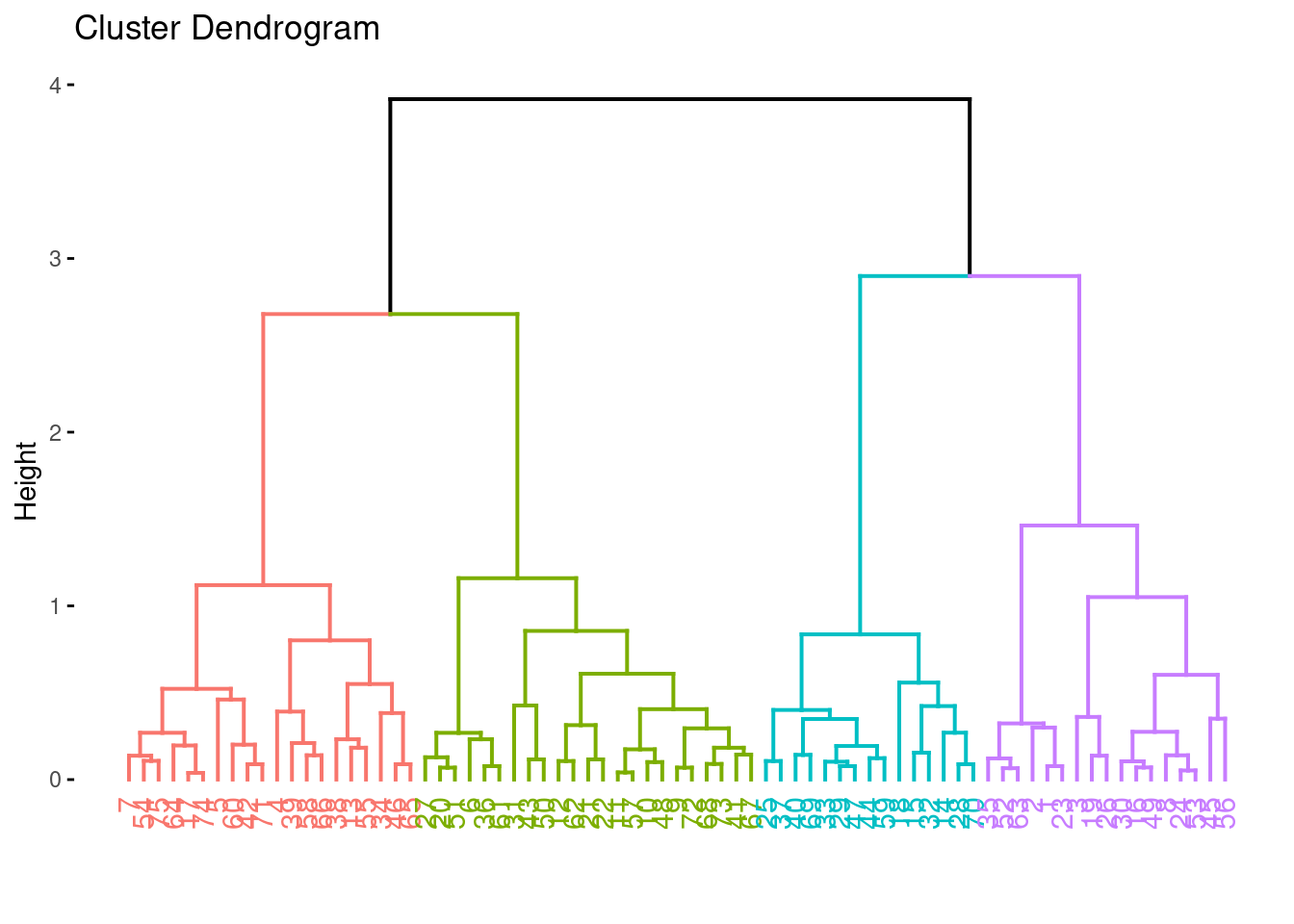
its[size(its) > 8] |> inspect()
## items support count
## [1] {hair,
## milk,
## toothed,
## backbone,
## breathes,
## legs,
## tail,
## catsize,
## type=mammal} 0.23762 24
## [2] {hair,
## milk,
## predator,
## toothed,
## backbone,
## breathes,
## legs,
## catsize,
## type=mammal} 0.15842 16
## [3] {hair,
## milk,
## predator,
## toothed,
## backbone,
## breathes,
## legs,
## tail,
## type=mammal} 0.14851 15
## [4] {hair,
## milk,
## predator,
## backbone,
## breathes,
## legs,
## tail,
## catsize,
## type=mammal} 0.13861 14
## [5] {hair,
## milk,
## predator,
## toothed,
## breathes,
## legs,
## tail,
## catsize,
## type=mammal} 0.12871 13
## [6] {hair,
## milk,
## predator,
## toothed,
## backbone,
## legs,
## tail,
## catsize,
## type=mammal} 0.12871 13
## [7] {hair,
## milk,
## predator,
## toothed,
## backbone,
## breathes,
## tail,
## catsize,
## type=mammal} 0.12871 13
## [8] {milk,
## predator,
## toothed,
## backbone,
## breathes,
## legs,
## tail,
## catsize,
## type=mammal} 0.12871 13
## [9] {hair,
## milk,
## predator,
## toothed,
## backbone,
## breathes,
## legs,
## tail,
## catsize} 0.12871 13
## [10] {hair,
## predator,
## toothed,
## backbone,
## breathes,
## legs,
## tail,
## catsize,
## type=mammal} 0.12871 13
## [11] {hair,
## milk,
## predator,
## toothed,
## backbone,
## breathes,
## legs,
## tail,
## catsize,
## type=mammal} 0.12871 13
## [12] {hair,
## milk,
## toothed,
## backbone,
## breathes,
## legs,
## domestic,
## catsize,
## type=mammal} 0.05941 6
## [13] {hair,
## milk,
## toothed,
## backbone,
## breathes,
## legs,
## tail,
## domestic,
## type=mammal} 0.05941 6
## [14] {feathers,
## eggs,
## airborne,
## predator,
## backbone,
## breathes,
## legs,
## tail,
## type=bird} 0.05941 65.3 Rules Generation
We use the APRIORI algorithm (see
? apriori)
rules <- apriori(trans, parameter = list(support = 0.05, confidence = 0.9))
## Apriori
##
## Parameter specification:
## confidence minval smax arem aval originalSupport maxtime support
## 0.9 0.1 1 none FALSE TRUE 5 0.05
## minlen maxlen target ext
## 1 10 rules TRUE
##
## Algorithmic control:
## filter tree heap memopt load sort verbose
## 0.1 TRUE TRUE FALSE TRUE 2 TRUE
##
## Absolute minimum support count: 5
##
## set item appearances ...[0 item(s)] done [0.00s].
## set transactions ...[23 item(s), 101 transaction(s)] done [0.00s].
## sorting and recoding items ... [21 item(s)] done [0.00s].
## creating transaction tree ... done [0.00s].
## checking subsets of size 1 2 3 4 5 6 7 8 9 10
## Warning in apriori(trans, parameter = list(support = 0.05, confidence
## = 0.9)): Mining stopped (maxlen reached). Only patterns up to a
## length of 10 returned!
## done [0.00s].
## writing ... [7174 rule(s)] done [0.00s].
## creating S4 object ... done [0.00s].
length(rules)
## [1] 7174
rules |> head() |> inspect()
## lhs rhs support confidence coverage
## [1] {type=insect} => {eggs} 0.07921 1.0 0.07921
## [2] {type=insect} => {legs} 0.07921 1.0 0.07921
## [3] {type=insect} => {breathes} 0.07921 1.0 0.07921
## [4] {type=mollusc.et.al} => {eggs} 0.08911 0.9 0.09901
## [5] {type=fish} => {fins} 0.12871 1.0 0.12871
## [6] {type=fish} => {aquatic} 0.12871 1.0 0.12871
## lift count
## [1] 1.712 8
## [2] 1.295 8
## [3] 1.262 8
## [4] 1.541 9
## [5] 5.941 13
## [6] 2.806 13
rules |> head() |> quality()
## support confidence coverage lift count
## 1 0.07921 1.0 0.07921 1.712 8
## 2 0.07921 1.0 0.07921 1.295 8
## 3 0.07921 1.0 0.07921 1.262 8
## 4 0.08911 0.9 0.09901 1.541 9
## 5 0.12871 1.0 0.12871 5.941 13
## 6 0.12871 1.0 0.12871 2.806 13Look at rules with highest lift
rules <- sort(rules, by = "lift")
rules |> head(n = 10) |> inspect()
## lhs rhs support
## [1] {eggs, fins} => {type=fish} 0.12871
## [2] {eggs, aquatic, fins} => {type=fish} 0.12871
## [3] {eggs, predator, fins} => {type=fish} 0.08911
## [4] {eggs, toothed, fins} => {type=fish} 0.12871
## [5] {eggs, fins, tail} => {type=fish} 0.12871
## [6] {eggs, backbone, fins} => {type=fish} 0.12871
## [7] {eggs, aquatic, predator, fins} => {type=fish} 0.08911
## [8] {eggs, aquatic, toothed, fins} => {type=fish} 0.12871
## [9] {eggs, aquatic, fins, tail} => {type=fish} 0.12871
## [10] {eggs, aquatic, backbone, fins} => {type=fish} 0.12871
## confidence coverage lift count
## [1] 1 0.12871 7.769 13
## [2] 1 0.12871 7.769 13
## [3] 1 0.08911 7.769 9
## [4] 1 0.12871 7.769 13
## [5] 1 0.12871 7.769 13
## [6] 1 0.12871 7.769 13
## [7] 1 0.08911 7.769 9
## [8] 1 0.12871 7.769 13
## [9] 1 0.12871 7.769 13
## [10] 1 0.12871 7.769 13Create rules using the alternative encoding (with “FALSE” item)
r <- apriori(trans_factors)
## Apriori
##
## Parameter specification:
## confidence minval smax arem aval originalSupport maxtime support
## 0.8 0.1 1 none FALSE TRUE 5 0.1
## minlen maxlen target ext
## 1 10 rules TRUE
##
## Algorithmic control:
## filter tree heap memopt load sort verbose
## 0.1 TRUE TRUE FALSE TRUE 2 TRUE
##
## Absolute minimum support count: 10
##
## set item appearances ...[0 item(s)] done [0.00s].
## set transactions ...[39 item(s), 101 transaction(s)] done [0.00s].
## sorting and recoding items ... [34 item(s)] done [0.00s].
## creating transaction tree ... done [0.00s].
## checking subsets of size 1 2 3 4 5 6 7 8 9 10
## Warning in apriori(trans_factors): Mining stopped (maxlen reached).
## Only patterns up to a length of 10 returned!
## done [0.06s].
## writing ... [1517191 rule(s)] done [0.17s].
## creating S4 object ... done [0.62s].
r
## set of 1517191 rules
print(object.size(r), unit = "Mb")
## 110.2 Mb
inspect(r[1:10])
## lhs rhs support confidence coverage
## [1] {} => {feathers=FALSE} 0.8020 0.8020 1.0000
## [2] {} => {backbone=TRUE} 0.8218 0.8218 1.0000
## [3] {} => {fins=FALSE} 0.8317 0.8317 1.0000
## [4] {} => {domestic=FALSE} 0.8713 0.8713 1.0000
## [5] {} => {venomous=FALSE} 0.9208 0.9208 1.0000
## [6] {domestic=TRUE} => {predator=FALSE} 0.1089 0.8462 0.1287
## [7] {domestic=TRUE} => {aquatic=FALSE} 0.1188 0.9231 0.1287
## [8] {domestic=TRUE} => {legs=TRUE} 0.1188 0.9231 0.1287
## [9] {domestic=TRUE} => {breathes=TRUE} 0.1188 0.9231 0.1287
## [10] {domestic=TRUE} => {backbone=TRUE} 0.1188 0.9231 0.1287
## lift count
## [1] 1.000 81
## [2] 1.000 83
## [3] 1.000 84
## [4] 1.000 88
## [5] 1.000 93
## [6] 1.899 11
## [7] 1.434 12
## [8] 1.195 12
## [9] 1.165 12
## [10] 1.123 12
r |> head(n = 10, by = "lift") |> inspect()
## lhs rhs support confidence coverage lift count
## [1] {breathes=FALSE,
## fins=TRUE} => {type=fish} 0.1287 1 0.1287 7.769 13
## [2] {eggs=TRUE,
## fins=TRUE} => {type=fish} 0.1287 1 0.1287 7.769 13
## [3] {milk=FALSE,
## fins=TRUE} => {type=fish} 0.1287 1 0.1287 7.769 13
## [4] {breathes=FALSE,
## fins=TRUE,
## legs=FALSE} => {type=fish} 0.1287 1 0.1287 7.769 13
## [5] {aquatic=TRUE,
## breathes=FALSE,
## fins=TRUE} => {type=fish} 0.1287 1 0.1287 7.769 13
## [6] {hair=FALSE,
## breathes=FALSE,
## fins=TRUE} => {type=fish} 0.1287 1 0.1287 7.769 13
## [7] {eggs=TRUE,
## breathes=FALSE,
## fins=TRUE} => {type=fish} 0.1287 1 0.1287 7.769 13
## [8] {milk=FALSE,
## breathes=FALSE,
## fins=TRUE} => {type=fish} 0.1287 1 0.1287 7.769 13
## [9] {toothed=TRUE,
## breathes=FALSE,
## fins=TRUE} => {type=fish} 0.1287 1 0.1287 7.769 13
## [10] {breathes=FALSE,
## fins=TRUE,
## tail=TRUE} => {type=fish} 0.1287 1 0.1287 7.769 135.3.1 Calculate Additional Interest Measures
interestMeasure(rules[1:10], measure = c("phi", "gini"),
trans = trans)
## phi gini
## 1 1.0000 0.2243
## 2 1.0000 0.2243
## 3 0.8138 0.1485
## 4 1.0000 0.2243
## 5 1.0000 0.2243
## 6 1.0000 0.2243
## 7 0.8138 0.1485
## 8 1.0000 0.2243
## 9 1.0000 0.2243
## 10 1.0000 0.2243Add measures to the rules
quality(rules) <- cbind(quality(rules),
interestMeasure(rules, measure = c("phi", "gini"),
trans = trans))Find rules which score high for Phi correlation
rules |> head(by = "phi") |> inspect()
## lhs rhs support confidence
## [1] {eggs, fins} => {type=fish} 0.1287 1
## [2] {eggs, aquatic, fins} => {type=fish} 0.1287 1
## [3] {eggs, toothed, fins} => {type=fish} 0.1287 1
## [4] {eggs, fins, tail} => {type=fish} 0.1287 1
## [5] {eggs, backbone, fins} => {type=fish} 0.1287 1
## [6] {eggs, aquatic, toothed, fins} => {type=fish} 0.1287 1
## coverage lift count phi gini
## [1] 0.1287 7.769 13 1 0.2243
## [2] 0.1287 7.769 13 1 0.2243
## [3] 0.1287 7.769 13 1 0.2243
## [4] 0.1287 7.769 13 1 0.2243
## [5] 0.1287 7.769 13 1 0.2243
## [6] 0.1287 7.769 13 1 0.22435.3.2 Mine Using Templates
Sometimes it is beneficial to specify what items should be where in the
rule. For apriori we can use the parameter appearance to specify this
(see
? APappearance).
In the following we restrict rules to an animal type in the RHS and
any item in the LHS.
type <- grep("type=", itemLabels(trans), value = TRUE)
type
## [1] "type=mammal" "type=bird" "type=reptile"
## [4] "type=fish" "type=amphibian" "type=insect"
## [7] "type=mollusc.et.al"
rules_type <- apriori(trans, appearance= list(rhs = type))
## Apriori
##
## Parameter specification:
## confidence minval smax arem aval originalSupport maxtime support
## 0.8 0.1 1 none FALSE TRUE 5 0.1
## minlen maxlen target ext
## 1 10 rules TRUE
##
## Algorithmic control:
## filter tree heap memopt load sort verbose
## 0.1 TRUE TRUE FALSE TRUE 2 TRUE
##
## Absolute minimum support count: 10
##
## set item appearances ...[7 item(s)] done [0.00s].
## set transactions ...[23 item(s), 101 transaction(s)] done [0.00s].
## sorting and recoding items ... [18 item(s)] done [0.00s].
## creating transaction tree ... done [0.00s].
## checking subsets of size 1 2 3 4 5 6 7 8 9 10
## Warning in apriori(trans, appearance = list(rhs = type)): Mining
## stopped (maxlen reached). Only patterns up to a length of 10
## returned!
## done [0.00s].
## writing ... [571 rule(s)] done [0.00s].
## creating S4 object ... done [0.00s].
rules_type |> sort(by = "lift") |> head() |> inspect()
## lhs rhs support confidence
## [1] {eggs, fins} => {type=fish} 0.1287 1
## [2] {eggs, aquatic, fins} => {type=fish} 0.1287 1
## [3] {eggs, toothed, fins} => {type=fish} 0.1287 1
## [4] {eggs, fins, tail} => {type=fish} 0.1287 1
## [5] {eggs, backbone, fins} => {type=fish} 0.1287 1
## [6] {eggs, aquatic, toothed, fins} => {type=fish} 0.1287 1
## coverage lift count
## [1] 0.1287 7.769 13
## [2] 0.1287 7.769 13
## [3] 0.1287 7.769 13
## [4] 0.1287 7.769 13
## [5] 0.1287 7.769 13
## [6] 0.1287 7.769 13Saving rules as a CSV-file to be opened with Excel or other tools.
write(rules, file = "rules.csv", quote = TRUE)
5.4 Compact Representation of Frequent Itemsets
Find maximal frequent itemsets (no superset if frequent)
its_max <- its[is.maximal(its)]
its_max
## set of 22 itemsets
its_max |> head(by = "support") |> inspect()
## items support count
## [1] {hair,
## milk,
## predator,
## toothed,
## backbone,
## breathes,
## legs,
## tail,
## catsize,
## type=mammal} 0.12871 13
## [2] {eggs,
## aquatic,
## predator,
## toothed,
## backbone,
## fins,
## tail,
## type=fish} 0.08911 9
## [3] {aquatic,
## predator,
## toothed,
## backbone,
## breathes} 0.07921 8
## [4] {aquatic,
## predator,
## toothed,
## backbone,
## fins,
## tail,
## catsize} 0.06931 7
## [5] {eggs,
## venomous} 0.05941 6
## [6] {predator,
## venomous} 0.05941 6Find closed frequent itemsets (no superset if frequent)
its_closed <- its[is.closed(its)]
its_closed
## set of 230 itemsets
its_closed |> head(by = "support") |> inspect()
## items support count
## [1] {backbone} 0.8218 83
## [2] {breathes} 0.7921 80
## [3] {legs} 0.7723 78
## [4] {tail} 0.7426 75
## [5] {backbone, tail} 0.7327 74
## [6] {breathes, legs} 0.7228 73
counts <- c(
frequent=length(its),
closed=length(its_closed),
maximal=length(its_max)
)
ggplot(as_tibble(counts, rownames = "Itemsets"),
aes(Itemsets, counts)) + geom_bar(stat = "identity")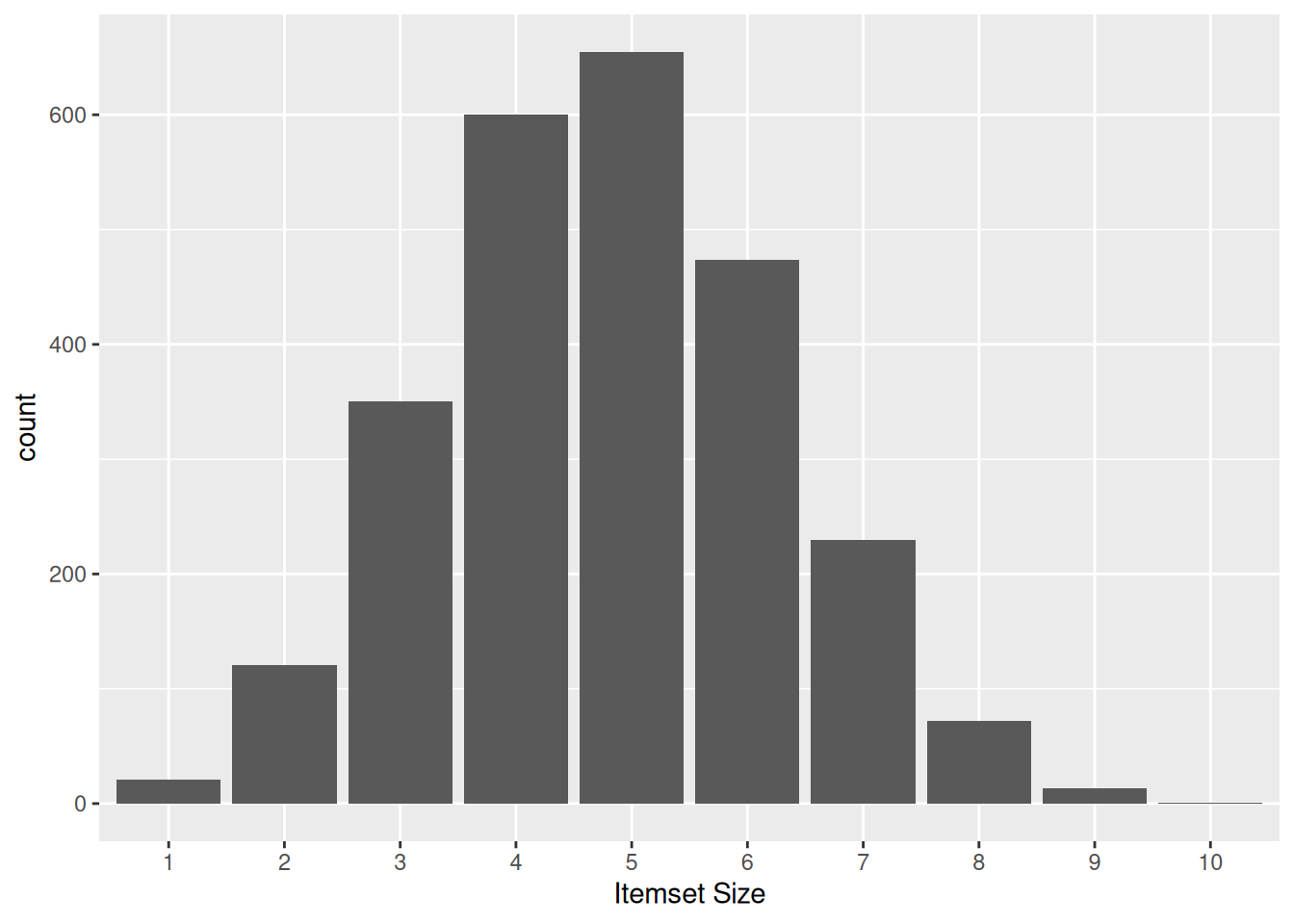
5.5 Association Rule Visualization*
Visualization is a very powerful approach to analyse large sets of mined association rules and frequent itemsets. We present here some options to create static visualizations and inspect rule sets interactively.
5.5.1 Static Visualizations
Default scatterplot
plot(rules)
## To reduce overplotting, jitter is added! Use jitter = 0 to prevent jitter.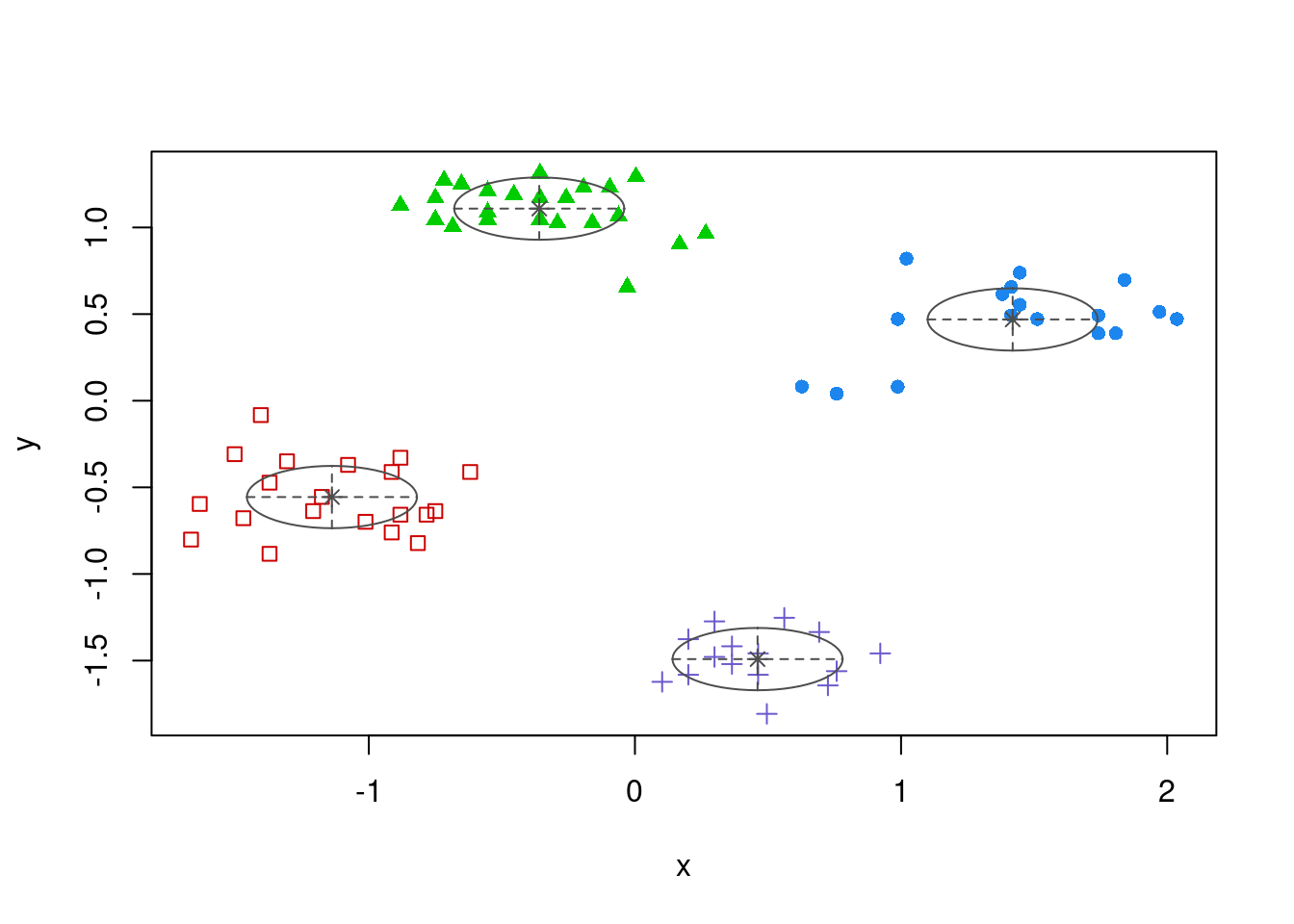
Note that some jitter (randomly move points) was added to show how many rules have the same confidence and support value. Without jitter:
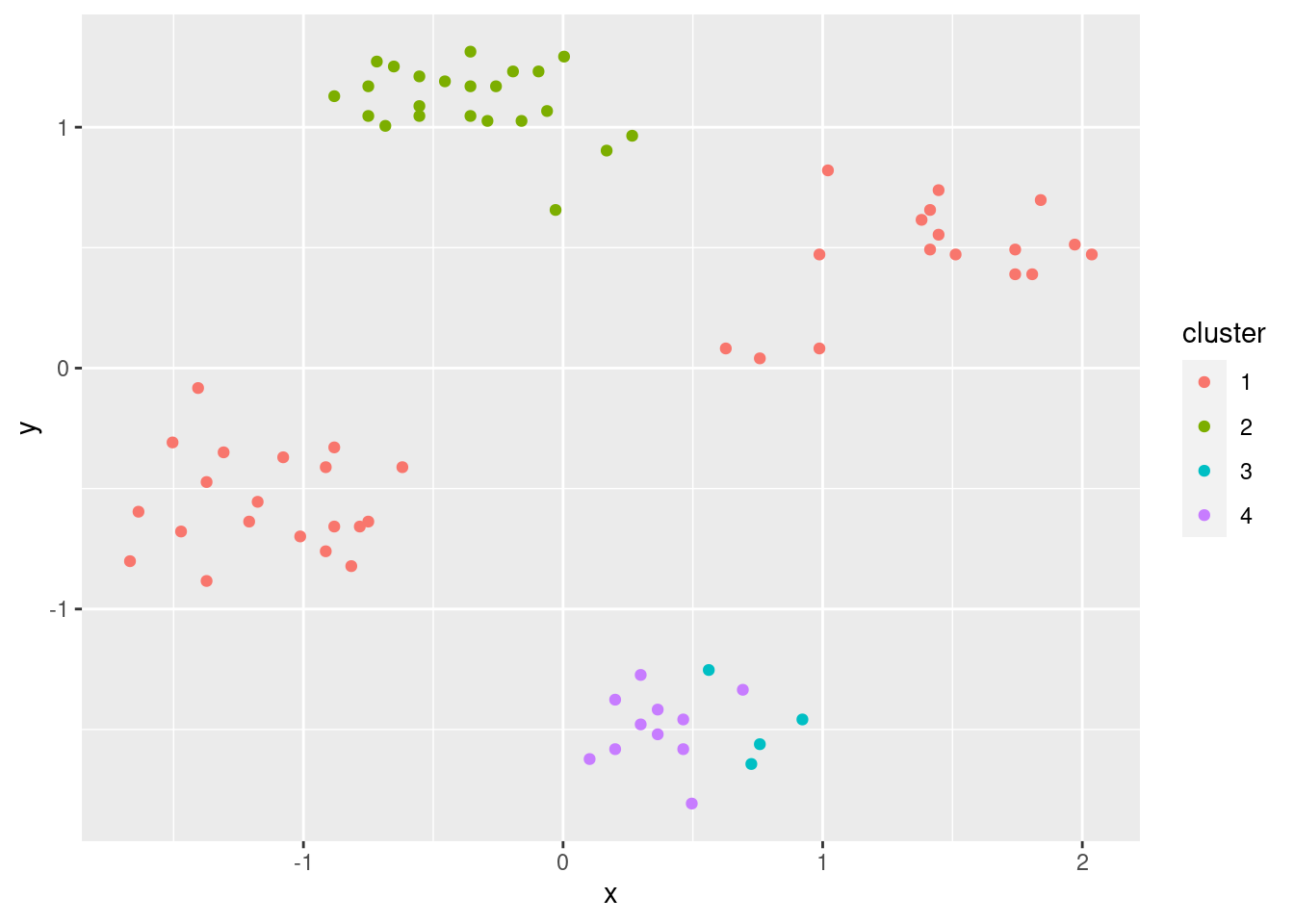
plot(rules, shading = "order")
## To reduce overplotting, jitter is added! Use jitter = 0 to prevent jitter.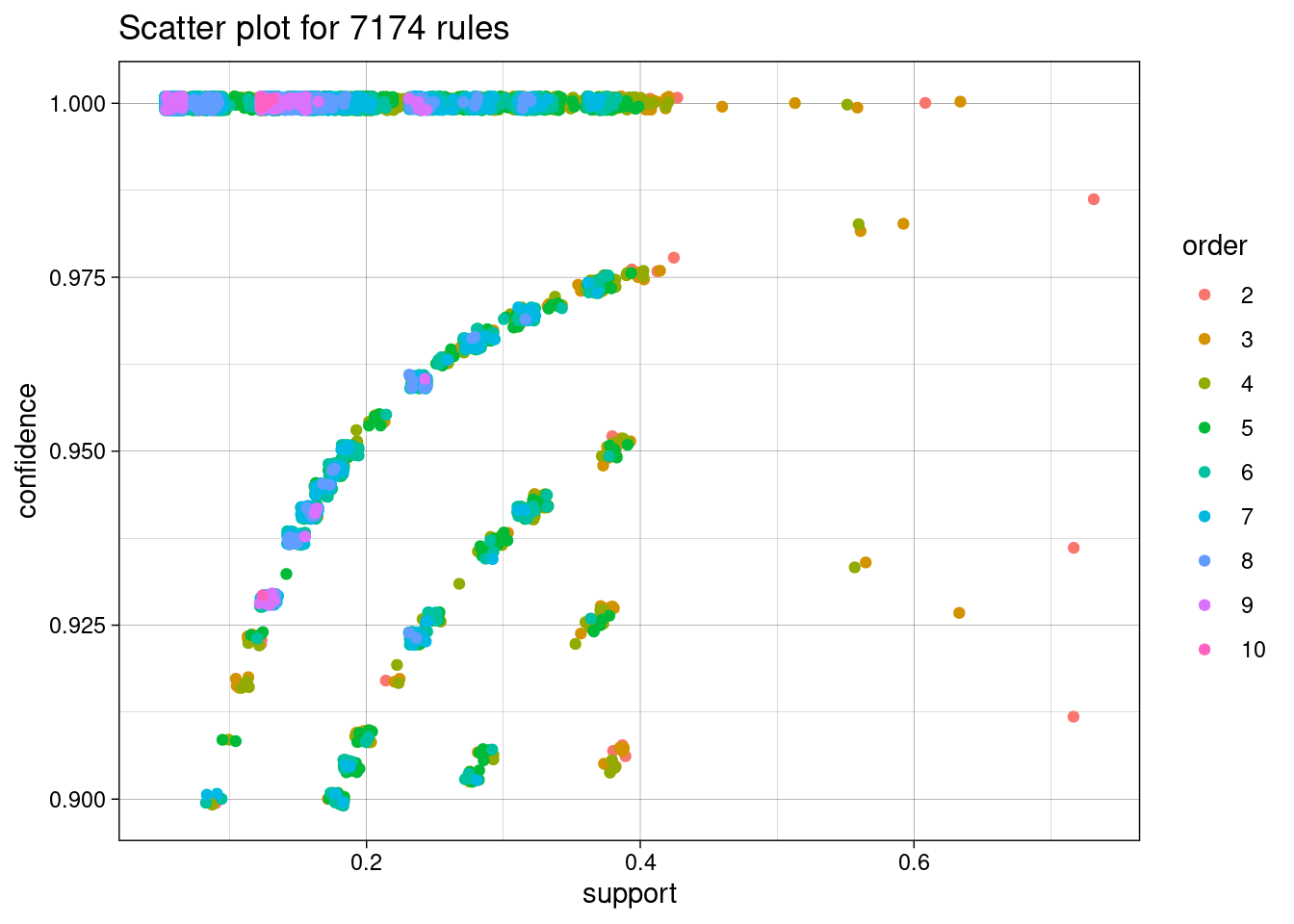
##plot(rules, interactive = TRUE)Grouped plot
plot(rules, method = "grouped")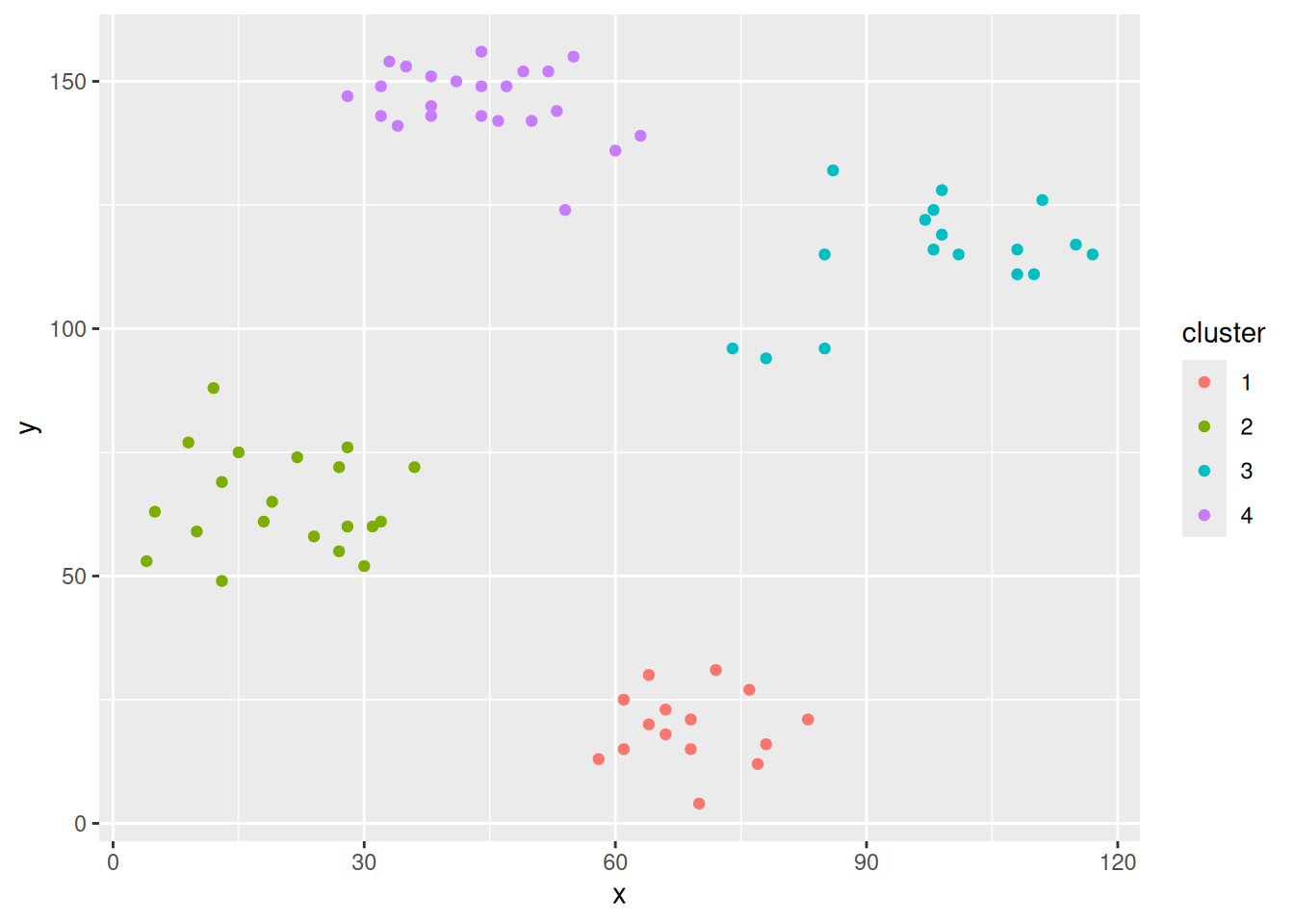
##plot(rules, method = "grouped", engine = "interactive")As a graph
plot(rules, method = "graph")
## Warning: Too many rules supplied. Only plotting the best 100 using
## 'lift' (change control parameter max if needed).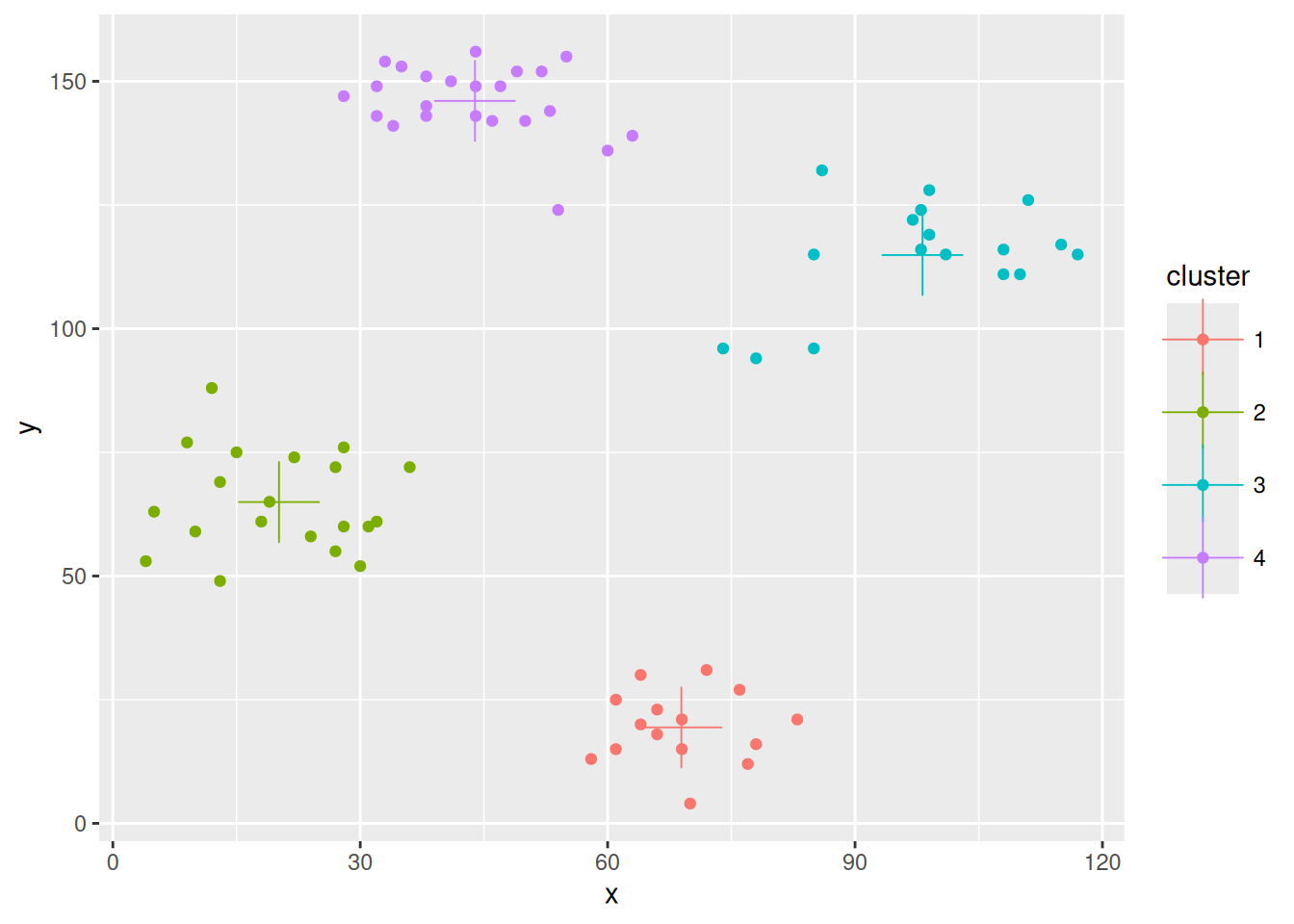
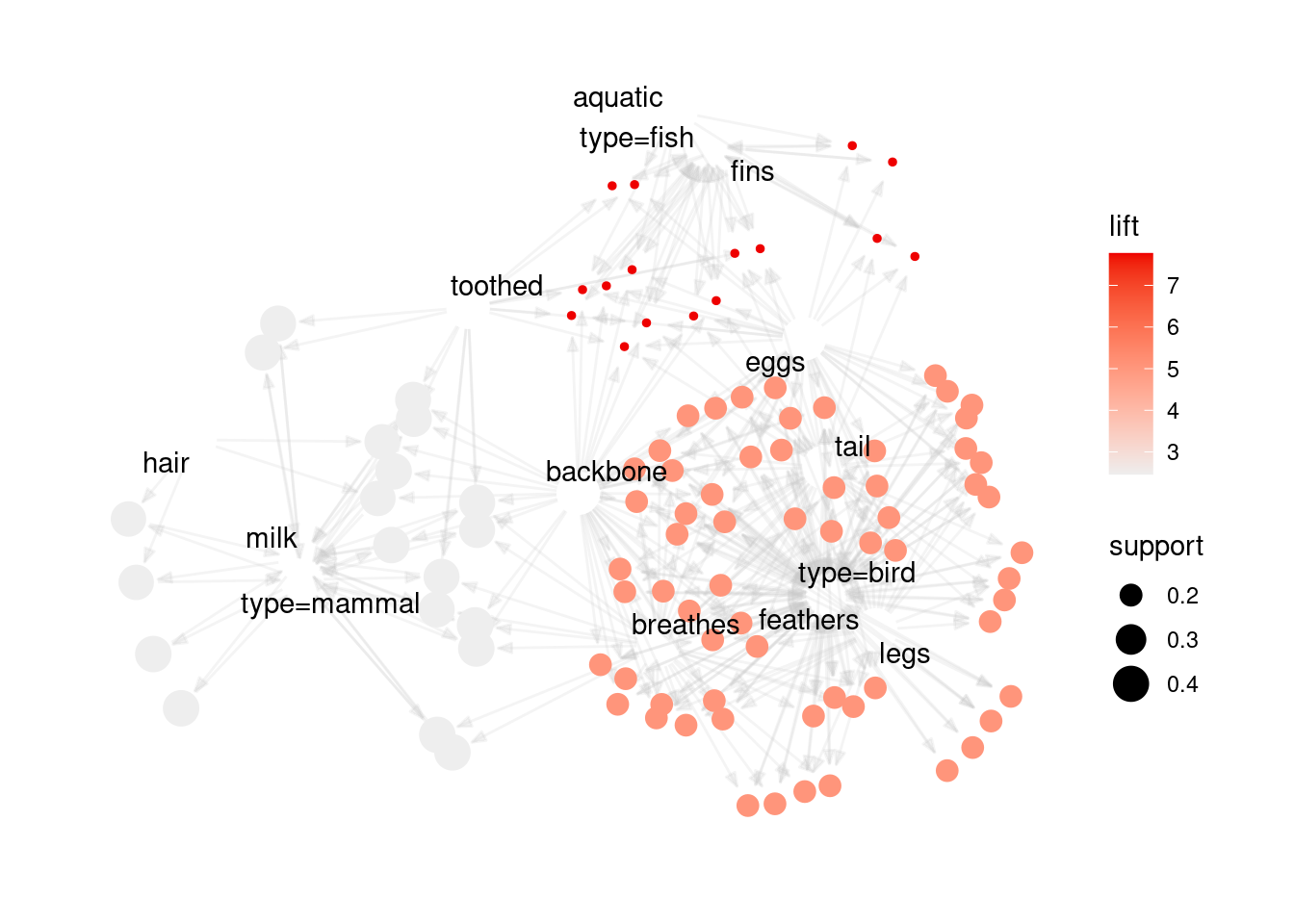
5.5.2 Interactive Visualizations
We will use the association rules mined from the Iris dataset for the following examples.
data(iris)
summary(iris)
## Sepal.Length Sepal.Width Petal.Length Petal.Width
## Min. :4.30 Min. :2.00 Min. :1.00 Min. :0.1
## 1st Qu.:5.10 1st Qu.:2.80 1st Qu.:1.60 1st Qu.:0.3
## Median :5.80 Median :3.00 Median :4.35 Median :1.3
## Mean :5.84 Mean :3.06 Mean :3.76 Mean :1.2
## 3rd Qu.:6.40 3rd Qu.:3.30 3rd Qu.:5.10 3rd Qu.:1.8
## Max. :7.90 Max. :4.40 Max. :6.90 Max. :2.5
## Species
## setosa :50
## versicolor:50
## virginica :50
##
##
## Convert the data to transactions.
iris_trans <- transactions(iris)
## Warning: Column(s) 1, 2, 3, 4 not logical or factor. Applying default
## discretization (see '? discretizeDF').Note that this conversion gives a warning to indicate that some potentially unwanted conversion happens. Some features are numeric and need to be discretized. The conversion automatically applies frequency-based discretization with 3 classes to each numeric feature, however, the use may want to use a different discretization strategy.
iris_trans |> head() |> inspect()
## items transactionID
## [1] {Sepal.Length=[4.3,5.4),
## Sepal.Width=[3.2,4.4],
## Petal.Length=[1,2.63),
## Petal.Width=[0.1,0.867),
## Species=setosa} 1
## [2] {Sepal.Length=[4.3,5.4),
## Sepal.Width=[2.9,3.2),
## Petal.Length=[1,2.63),
## Petal.Width=[0.1,0.867),
## Species=setosa} 2
## [3] {Sepal.Length=[4.3,5.4),
## Sepal.Width=[3.2,4.4],
## Petal.Length=[1,2.63),
## Petal.Width=[0.1,0.867),
## Species=setosa} 3
## [4] {Sepal.Length=[4.3,5.4),
## Sepal.Width=[2.9,3.2),
## Petal.Length=[1,2.63),
## Petal.Width=[0.1,0.867),
## Species=setosa} 4
## [5] {Sepal.Length=[4.3,5.4),
## Sepal.Width=[3.2,4.4],
## Petal.Length=[1,2.63),
## Petal.Width=[0.1,0.867),
## Species=setosa} 5
## [6] {Sepal.Length=[5.4,6.3),
## Sepal.Width=[3.2,4.4],
## Petal.Length=[1,2.63),
## Petal.Width=[0.1,0.867),
## Species=setosa} 6Next, we mine association rules.
rules <- apriori(iris_trans, parameter = list(support = 0.1, confidence = 0.8))
## Apriori
##
## Parameter specification:
## confidence minval smax arem aval originalSupport maxtime support
## 0.8 0.1 1 none FALSE TRUE 5 0.1
## minlen maxlen target ext
## 1 10 rules TRUE
##
## Algorithmic control:
## filter tree heap memopt load sort verbose
## 0.1 TRUE TRUE FALSE TRUE 2 TRUE
##
## Absolute minimum support count: 15
##
## set item appearances ...[0 item(s)] done [0.00s].
## set transactions ...[15 item(s), 150 transaction(s)] done [0.00s].
## sorting and recoding items ... [15 item(s)] done [0.00s].
## creating transaction tree ... done [0.00s].
## checking subsets of size 1 2 3 4 5 done [0.00s].
## writing ... [144 rule(s)] done [0.00s].
## creating S4 object ... done [0.00s].
rules
## set of 144 rules5.5.2.2 Scatter Plot
Plot rules as a scatter plot using an interactive html widget. To avoid
overplotting, jitter is added automatically. Set jitter = 0 to disable
jitter. Hovering over rules shows rule information. Note:
plotly/javascript does not do well with too many points, so plot selects
the top 1000 rules with a warning if more rules are supplied.
plot(rules, engine = "html")
## To reduce overplotting, jitter is added! Use jitter = 0 to prevent jitter.5.5.2.3 Matrix Visualization
Plot rules as a matrix using an interactive html widget.
plot(rules, method = "matrix", engine = "html") 5.5.2.4 Visualization as Graph
Plot rules as a graph using an interactive html widget. Note: the used javascript library does not do well with too many graph nodes, so plot selects the top 100 rules only (with a warning).
plot(rules, method = "graph", engine = "html")
## Warning: Too many rules supplied. Only plotting the best 100 using
## 'lift' (change control parameter max if needed).5.5.2.5 Interactive Rule Explorer
You can specify a rule set or a dataset. To explore rules that can be
mined from iris, use: ruleExplorer(iris)
The rule explorer creates an interactive Shiny application that can be used locally or deployed on a server for sharing. A deployed version of the ruleExplorer is available here (using shinyapps.io).
5.6 Exercises*
We will again use the Palmer penguin data for the exercises.
library(palmerpenguins)
head(penguins)
## # A tibble: 6 × 8
## species island bill_length_mm bill_depth_mm flipper_length_mm
## <chr> <chr> <dbl> <dbl> <dbl>
## 1 Adelie Torgersen 39.1 18.7 181
## 2 Adelie Torgersen 39.5 17.4 186
## 3 Adelie Torgersen 40.3 18 195
## 4 Adelie Torgersen NA NA NA
## 5 Adelie Torgersen 36.7 19.3 193
## 6 Adelie Torgersen 39.3 20.6 190
## # ℹ 3 more variables: body_mass_g <dbl>, sex <chr>, year <dbl>- Translate the penguin data into transaction data with:
trans <- transactions(penguins)
## Warning: Column(s) 1, 2, 3, 4, 5, 6, 7, 8 not logical or factor.
## Applying default discretization (see '? discretizeDF').
## Warning in discretize(x = c(2007, 2007, 2007, 2007, 2007, 2007, 2007, 2007, : The calculated breaks are: 2007, 2008, 2009, 2009
## Only unique breaks are used reducing the number of intervals. Look at ? discretize for details.
trans
## transactions in sparse format with
## 344 transactions (rows) and
## 22 items (columns)Why does the conversion report warnings?
- What do the following first three transactions mean?
inspect(trans[1:3])
## items transactionID
## [1] {species=Adelie,
## island=Torgersen,
## bill_length_mm=[32.1,40.8),
## bill_depth_mm=[18.3,21.5],
## flipper_length_mm=[172,192),
## body_mass_g=[3.7e+03,4.55e+03),
## sex=male,
## year=[2007,2008)} 1
## [2] {species=Adelie,
## island=Torgersen,
## bill_length_mm=[32.1,40.8),
## bill_depth_mm=[16.2,18.3),
## flipper_length_mm=[172,192),
## body_mass_g=[3.7e+03,4.55e+03),
## sex=female,
## year=[2007,2008)} 2
## [3] {species=Adelie,
## island=Torgersen,
## bill_length_mm=[32.1,40.8),
## bill_depth_mm=[16.2,18.3),
## flipper_length_mm=[192,209),
## body_mass_g=[2.7e+03,3.7e+03),
## sex=female,
## year=[2007,2008)} 3Next, use the ruleExplorer() function to analyze association rules
created for the transaction data set.
Use the default settings for the parameters. Using the Data Table, what is the association rule with the highest lift. What does its LHS, RHS, support, confidence and lift mean?
Use the Graph visualization. Use select by id to highlight different species and different islands and then hover over some of the rules. What do you see?